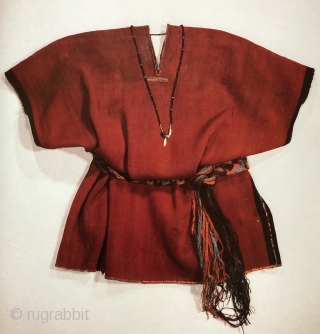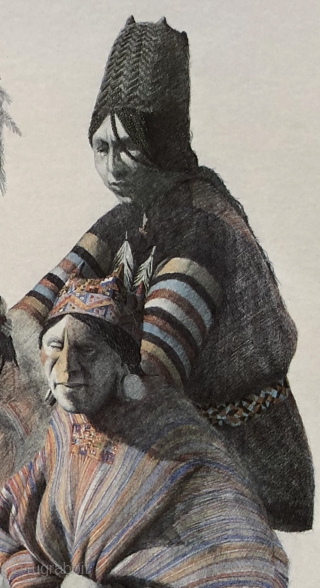Back
The colors of this sophisticated Pre-Columbian braided textile from Northern Chile are remarkable. Textiles of this type are exceedingly rare outside of Chilean Museums (see other examples inside). This fragment is from the period a.d. 300 - 700 - which in Northern Chile is called the Cabuza Fase. Made from soft, fine alpaca yarns, these sashes were worn wrapped around the waist of a warp-faced woven tunic - the main male garment in the Andes at the time. This fragment measures 30 x 5.5 inches. It is wider than most such belts and when complete, would have had about 40 inches of the complex braided work before separating into multiple, monochrome braids of each of the colors used in the textile. These long braided loose ends were used to tie it around the waist. (See images above of a similar sash from the Museo Chilean de Arte Precolumbino in Santiago.) The indigenous culture that created these belts were likely Aymara speakers and had their origins in the high Andean Altiplano where sophisticated textiles of all kinds had been made for millennia. This piece was once mounted to a backing cloth and framed for display. It would be very simple to re-mount it in this way. The piece has a wonderful surface and texture and the colors are very pleasing. The complicated braiding technique is exquisitely done and fascinating to study.
price:
SOLD _ THANK YOU
- Home
- Antique Rugs by Region
- Category
- Profiles
- Post Items Free
- Albums
- Benaki Museum of Islamic Art
- Budapest: Ottoman Carpets
- Gulbenkian Museum
- Islamic Carpets. Brooklyn
- Islamic Textiles. Brooklyn
- Konya Museum: Rugs
- MKG, Hamburg
- MMA: Caucasian Carpets
- MMA: Mamluk Carpets
- MMA: Mughal Indian Carpets
- MMA: Ottoman Carpets
- MMA: Safavid Persian Carpets
- MMA: Turkmen Rugs
- McCoy Jones Kilims
- Ottoman textiles. Met
- Philadelphia Museum
- Rugs and Carpets: Berlin
- Seljuqs at the Met
- TIEM, Istanbul: Carpets
- V&A: Classical Carpets
- Vakiflar Carpets: Istanbul
- Baluch Rugs: Indianapolis
- Gallery Exhibitions
- Jaf an Exhibition
- Alberto Levi Gallery
- Andean Textile
- Christie's London: 2016
- Francesca Galloway
- HALI at 40
- ICOC Washington, DC 2018
- Jajims of the Shahsavan
- London Islamic Week April, 2018
- Mongolian Felts
- Navajo Rugs: JB Moore
- Persian Piled Weavings
- SF Tribal & Textile Art Show 2020
- SF Tribal 2019
- Sotheby's: C. Alexander
- Turkish Prayer Rugs
- Turkmen Main Carpets ICOC 2007

















